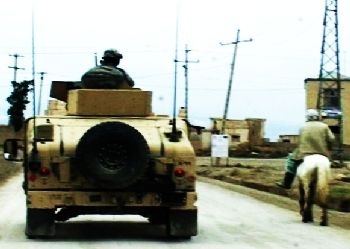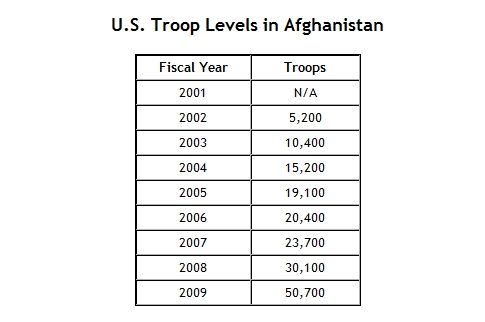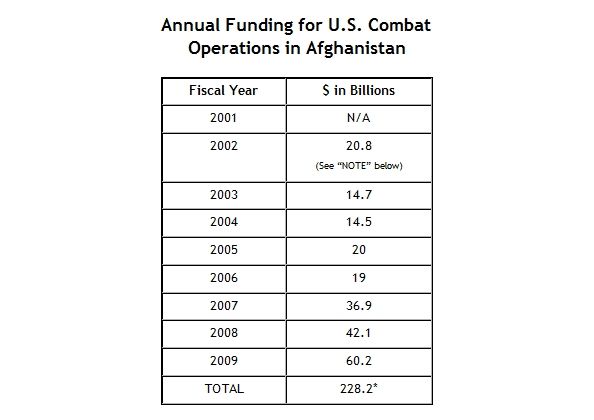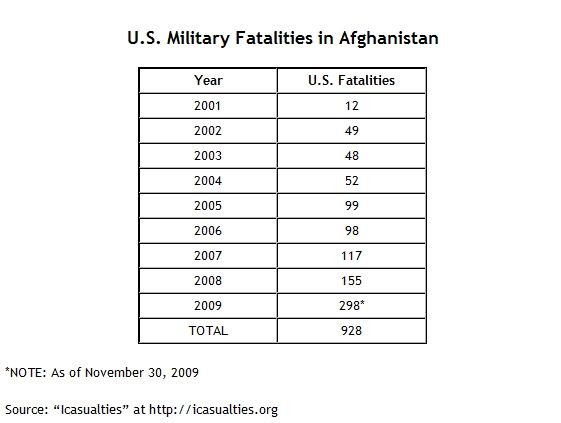
Publisher:
Bonnie King
CONTACT:
Newsroom@Salem-news.com
Advertising:
Adsales@Salem-news.com

~Truth~
~Justice~
~Peace~
TJP
Dec-01-2009 13:13

 TweetFollow @OregonNews
TweetFollow @OregonNews
Afghanistan Fact Sheet: The Numbers Behind the Troop Increase
Salem-News.comGroup says total funding for Afghanistan could exceed $325 billion in Fiscal Year 2010.
 Afghanistan 2007 by Tim King Salem-News.com |
(WASHINGTON D.C.) - President Barack Obama is making a major policy speech on Afghanistan tonight. According to numerous press reports, this speech will include his intention to significantly increase the number of U.S. forces deployed in the region to conduct combat operations and assist with the training of Afghanistan's national security forces.
The following are quick facts about the U.S. commitment in Afghanistan.
Funding Additional Troops
– U.S. Troop Levels in Afghanistan – historical data
– Annual Funding for U.S. Combat Operations in Afghanistan
– Figures of U.S. Military Fatalities in Afghanistan
– Link to NPP's “Cost of War” Counter
– Issues to Consider As Troop Levels Increase
– Funding for Military vs. Non-military Activities
– Reliance on Private Contractors
– Stress on the “Total Force”
– Staffing a “Civilian Surge”
Additional Resources
Funding Additional Troops Prior to Fiscal Year 2010, combat operations in Iraq and Afghanistan have been funded outside the normal Defense Department budget through “supplemental” spending bills. The Obama Administration pledged that it would end this practice after Fiscal Year 2009 and included, as part of its Fiscal Year 2010 budget request, a $130 billion request for “Overseas Contingency Operations,” the majority of which was dedicated to the Iraq and Afghanistan wars. The Fiscal Year 2010 funding, which awaits final approval from Congress, does not include the funds that will be required to support any further increase in U.S. troop levels in Afghanistan. Thus it is very likely that the White House will again resort to a supplemental spending bill to secure additional war funding in the coming year. It has been widely reported in recent weeks that both the Pentagon and the White House estimate that any additional forces sent to Afghanistan will require $1 billion per year for every 1,000 troops sent, or $1 million per soldier. IN ALL, total funding for Afghanistan could exceed $325 billion in Fiscal Year 2010. (See “Annual Funding for U.S. Combat Operations in Afghanistan” below.)
 (Congressional Research Service estimate, as of July 2009)* * It has been reported subsequently that there are roughly 62,000 U.S. troops currently in Afghanistan. This number is expected to grow to at least 68,000 by year's end. [“Gates Says Additional Local Forces May Be Needed In Afghan War,” Bloomberg News, September 1, 2009.] |
NOTE: The Defense Department reports troop levels involved in military operations in several ways. The figures shown here are taken from the Pentagon's “Boots on the Ground” (BOG) reports to Congress. They reflect only personnel located in Afghanistan and do not include other personnel deployed as part of Operation “Enduring Freedom,” such as those providing logistical support in neighboring countries. Source: “Troop Levels in the Afghan and Iraq Wars, FY2001-FY2012: Cost and Other Potential Issues,”CRS Report R40682, July 2, 2009, fas.org/sgp/crs/natsec/R40682.pdf

* Of the $130 billion for Fiscal Year 2010 operations in Iraq and Afghanistan currently awaiting final approval by Congress, roughly half, or around $65 billion, will likely go to Afghanistan. This additional funding will not cover any further increases in troop levels that President Obama might request. Adding in the cost of 30,000 additional troops (an estimated $30 billion), together with Afghanistan's portion of the $130 billion, total funding for Afghanistan could exceed $325 billion in Fiscal Year 2010.
NOTE: 2002 figure includes both FY 2001 and 2002 funding.
Source: “The Cost of Iraq, Afghanistan, and Other Global War on Terror Operations Since 9/11,” Congressional Research Service Report RL33110, Sept 28, 2009, fas.org/sgp/crs/natsec/RL33110.pdf

NPP's “Cost of War” Counter – See NPP's Afghanistan “Cost of War” Counter (http://www.costofwar.com/) and calculate the cost of the war to your state (and many cities or towns).
Issues to Consider
Funding for Military vs. Non-military Activities – In addition to increased numbers of combat forces in Afghanistan, President Obama will likely propose greater support for political and economic development. According to the Library of Congress's Congressional Research Service (CRS), 95 percent of total funding to date for Afghanistan has supported military operations, while only 5 percent of spending has supported development-related activities.
Reliance on Private Contractors – According to CRS, Defense Department contract employees outnumber U.S. military personnel in Afghanistan. As of June of this year, contractors made up 57 percent of U.S. military forces in Afghanistan, with 73,968 contractors relative to 55,107 uniformed personnel.
Source: “Department of Defense Contractors in Iraq and Afghanistan: Background and Analysis,” CRS Report number R40764, September 21, 2009, http://www.fas.org/sgp/crs/natsec/R40764.pdf
Stress on the “Total Force” – Many analysts believe that the U.S. military is already severely stressed by the size and duration of deployments in Iraq and Afghanistan. It is unclear what impact deployment of additional troops will have on the military and its ability to respond to events in other regions of the world.
Staffing a “Civilian Surge” – A number of U.S. civilian and military leaders, including Gen. Stanley McChrystal, commander of U.S. and NATO forces in Afghanistan, have indicated the need to send large numbers of additional State Department and U.S. Agency for International Development personnel to Afghanistan. Yet it is not clear that the personnel needed for these duties and the funds necessary to support them are available.
Additional Resources
Civilian Casualties – the Human Rights Unit of United Nations Assistance Mission to Afghanistan publishes an “Annual Report on the Protection of Civilians in Armed Conflict in Afghanistan.” http://unama.unmissions.org/Default.aspx?tabid=1816
Additional casualty data, plus background information on Afghanistan can be found in “The Cost of War in Afghanistan,” published jointly by NPP and the American Friends Service Committee. nationalpriorities.org/auxiliary/costofwar/cost_of_war_afghanistan.pdf
Source: National Priorities Project
Articles for November 30, 2009 | Articles for December 1, 2009 | Articles for December 2, 2009


googlec507860f6901db00.html



Terms of Service | Privacy Policy
All comments and messages are approved by people and self promotional links or unacceptable comments are denied.
[Return to Top]
©2025 Salem-News.com. All opinions expressed in this article are those of the author and do not necessarily reflect those of Salem-News.com.